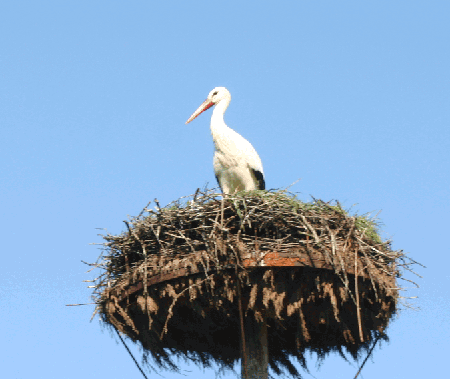

The great blue heron is a big wading bird of the same family as the storks.
It has a long white neck, a long and sharp beak and long legs.
It is characterized by a grey plumage and a breast speckled with black.
This bird has an average height of 1 m and weighs approximately
2 kg. Its life expectancy is 25 years.
It eats fish and frogs and consequently frequents all
the wet and shallow habitats.
These birds often nest in colonies.
The great blue heron can be found mainly in the western swampy regions. So we
can see it it throughout of the river Charente.
The Mallard drake is the most wide-spread
species of duck.
It measures between 50 and 60 cms and weighs between 850 g and 1,4
kg.
The male is characterized by its green head.
The female is beige, speckled with brown.
The Mallard drake has a life expectancy which can go up to 29 years. It eats
mainly frogs, insects, worms and seeds of all kinds.
It lives in fresh and shallow waters, in swamps, ponds and lakes.
Its main predators are the fox, the marten and naturally man.
The population of Mallard drake is numerous on the entire river the Charente.
The European Kingfisher is a small bird. It is characterized by a long beak, short legs and a richly coloured
plumage.
As its name indicates, the kingfisher essentially eats small fish,
but also water insects and small shellfish.
It can be found throughout the river Charente. The kingfisher is not a migrant;
it is thus present around the river all year long.
It nests in galleries within the banks of streams. This bird is very sensitive
to all types of pollution and very wary of man.
We find the Great Cormorant throughout
the course of the Charente. The Great Cormorant is a protected species because
it has long been persecuted by the fishermen, who saw it has a redoubtable
competitor.
The Great grown-up Cormorant has a black plumage, a long hooked beak,
and webbed feet. It feeds mainly on fish which it catches with its beak.
It swims under the water, by using its webbed feet to chase its prey. In
fresh water, the great cormorant can eat shellfish, frogs and diverse
insects.
This specie can be found along coasts and streams.
Its nest consists of big wooden branches and sometimes seaweeds.
The great cormorant can reproduce in any period of the year, depending on the
food its finds in the places in which it is.

The white stork is an African migratory
wading bird which comes to reproduce in Europe.
The white stork is a carnivorous bird which essentially eats worms, frogs,
small snakes, rodents and sometimes fish.
There are several species but the most famous are the black stork
and the white stork. The white stork is the one that we find on the river
the Charente.
Its presence in Charente-Maritime dates from 1841, but the species is considered
as very rare. From 1960 to 1966, several cases of nesting were observed in the region, especially in the swamp of Rochefort.
It was then necessary to wait till 1978 to see new couples settle down in
the swamps of Brouage thanks to artificial platforms set up by man.
The white stork has become a real attraction in Charente-Maritime,which has the greatest number of couples of white storks in France, after Alsace.